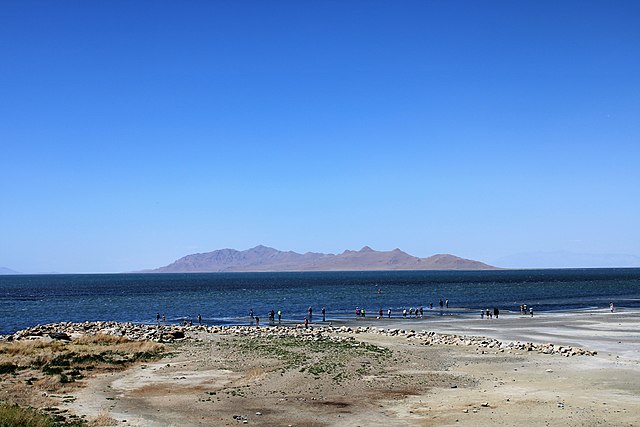
Scientists warn that the Great Salt Lake could disappear in just five years.
According to scientists in the United States, the Great Salt Lake will disappear in as little as five years if nothing is done to conserve water immediately in Utah.
At this point, in order to reverse the decline, annually enough water must flow back into the lake to cover more than 2.5 million acres (or 10,000 square kilometers).
To put that into perspective, an acre-foot of land holds approximately 326,000 gallons, or more than 1.2 million liters, of water.
Currently, Utah’s famous lake receives only about 0.1 million acre-feet of water annually, which is not even close to sufficient.
The lake has lost more than one million acre-feet of water annually since 2020.
According to research conducted by scientists at Brigham Young University (BYU), the region’s water consumption needs to be reduced by at least one third, if not by half, in order to save the ecosystem.
“Despite encouraging growth in legislative action and public awareness, most Utahns do not realize the urgency of this crisis,” the researchers write in a briefing on the issue, led by BYU ecologist Benjamin Abbott.
“Examples from around the world show that saline lake loss triggers a long-term cycle of environmental, health, and economic suffering. Without a coordinated rescue, we can expect widespread air and water pollution, numerous Endangered Species Act listings, and declines in agriculture, industry, and overall quality of life.”
The report urges Salt Lake City’s governor to immediately establish a watershed-wide emergency rescue of the city’s mascot.
Not only does the Great Salt Lake house important flora and fauna, but it also preserves the quality of the air, cleans the water, and regulates local weather, such as snowfall in nearby mountains.
However, the ecosystem appears to be reaching a dangerous tipping point, according to recent research. The lake’s salinity has begun to rise as a result of the annual removal of millions of liters of water. Currently, salt concentrations are so high that flora and fauna are having trouble surviving.
A mass extinction of photosynthetic microbes has caused the lake’s water to turn pink in some places, like the lake’s North Arm.
“The lake’s North Arm is a warning of what the future could hold unless streamflow is restored. Cut off by a railroad causeway in 1959, the North Arm receives almost no surface runoff,” the briefing explains.
“The lack of freshwater flow caused salinity to reach saturation, killing the microbialites and algae that form the base of the lake’s food web. The disrupted lake circulation temporarily caused the highest methylmercury levels in the country.”
Dust particles could release embedded arsenic, mercury, lead, copper, organic contaminants, and cyanotoxins into the air as the lake bed dries out. Crops can be harmed, soils can degrade, and snowmelt can be delayed as a result of dust released from the drying lake.
When a salt lake in California, similar to Utah’s, dried up due to human activity, more people there developed asthma and heart problems than ever before.
Unfortunately, the average Utahn who uses water can’t do much to help. They can get rid of their sprinklers, plant plants in their garden that don’t use a lot of water, and push for better environmental policies at the state and federal levels. However, almost all of the water they use in their home is treated and repurposed.
The majority of the water that is diverted from the Great Salt Lake and its catchment area, which covers approximately 23 million acres, is used for industrial agriculture. The irrigating of crops currently consumes three quarters of the lake’s watershed’s consumption, with mineral extraction consuming another 9%.
The best and possibly only way to save the lake is to reduce farmers’ reliance on irrigation; however, this will necessitate systematic changes in Utah and the states that surround it in terms of politics and society.
Researchers warn of disastrous outcomes if coordinated action is not taken in the first half of this year.
According to the researchers, “Facing this crisis will require conservation measures unprecedented in living memory.”
“Reversing the collapse of the Great Salt Lake system is perhaps the greatest challenge we have faced in the history of our state. However, history shows that our community is capable of just this kind of bold collective action.”
“For example, our Indigenous and pioneer predecessors adapted to natural variability in weather and climate that would have extinguished most civilizations.”
“More recently, when excessive withdrawals caused Utah Lake to go dry in 1934 and 1935, emergency changes to infrastructure and water policy were made, allowing the lake to refill.”
This is doable by Utahns. There’s still time.
The entire report can be found on the website of Brigham Young University.
——————————————————————————
At Natural World Fund, we are passionate about stopping the decline in our wildlife.
The declines in our wildlife is shocking and frightening. Without much more support, many of the animals we know and love will continue in their declines towards extinction.
When you help to restore a patch of degraded land through rewilding to forests, meadows, or wetlands, you have a massive impact on the biodiversity at a local level. You give animals a home and food that they otherwise would not have had, and it has a positive snowball effect for the food chain.
We are convinced that this is much better for the UK than growing lots of fast-growing coniferous trees, solely to remove carbon, that don’t actually help our animals to thrive.
This is why we stand for restoring nature in the UK through responsible rewilding. For us, it is the right thing to do. Let’s do what’s right for nature!
Support our work today at https://naturalworldfund.com/ and join in the solution!

